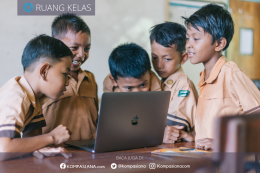By: Iyut Paneo; Supervised by: Muziatun, S.Pd, M.App. Ling, PhD
In social life, both in everyday life and life in the educational environment, there are variations in the language we use, for example, in everyday speech we often use casual language when talking to friends or people our age, there is also when we are in a classroom situation when making a presentation then of course we will use good language, which aims to make teachers, lecturers, and classmates understand what we explain. In addition, there are also situations where we speak using dialects from our language or other people's languages, as well as using a mixture of casual and standard language.
This term is known as an aspect of diglossia, diglossia is a study of sociolinguistic studies. Diglossia is a term that refers to a situation where there are two language variations used by a speech community for different functions and contexts. The context of diglossia has two variants known as the "High" variant which is used in formal domains, such as education, government, then the second variant is the "low" variant where this variant is used in informal communication / daily conversation.
The concept of diglossia was introduced by Ferguson in 1959, he argues that diglossia is a term that explains the situation about the form of language variation in a community, where this variation plays a function determined by its users (Halim & Yusoff, 2016). The variations referred to by Ferguson are high language variation [H] and low language variation [L]. According to takfiran dictionary Dewan (2005), diglossia is the form of two language variations in one language that follow the situation, one is higher in status if it is in a formal situation, while the other has a lower status and is used in informal situations.
The method used is a qualitative method, which will interview students with questions that have been prepared in advance. The respondent who will be interviewed on this topic is one of the students majoring in English education.
In the interview results, it was found that there were changes experienced by the respondents in the quality of the respondents' speech style, in the answers given by the respondents, the phenomenon of diglossia was found, such as: the use of language that follows according to the situation, context, and purpose of the conversation. The following are the respondents' answers and findings from the interviews:
Language variations that are often used
In daily activities, respondents use Informal and Formal language according to the context of the conversation, where when they are around family or friends they use more informal language. However, if they are already in a situation when meeting guests, talking with classmates, or lecturers, respondents will automatically switch to Formal language variations but are still often mixed a little with informal. And when they are in a situation that requires using formal language, such as an event, then the respondent will use full formal.
Style of speech used, formal or informal
When in class, the style of speech used by respondents is informal, where when talking with classmates about topics outside of lessons, respondents will use Informal language, but when discussing learning material, respondents will use formal variations with classmates, what respondents mean here is that the language used will be adjusted to the specific focus of the topic being discussed.
Changes in exchanging informal language variations to Formal variations







